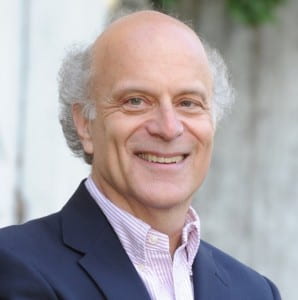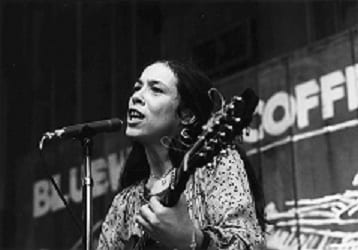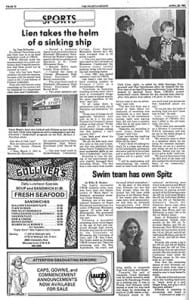Today’s UW-Green Bay students probably believe the Phoenix Bookstore has always been located in its spacious, modern digs on the plaza level of the University Union. Not even close. Prior to 2008, it was located on the library’s second floor and, going even further back, pre-1989, it occupied below-ground space in the Instructional Services Building.
R.I.P., Ol’ Blue
It happened suddenly, without much warning. A victim of progress and elevator-car update, the famous blue-shag carpeting on the walls of the Theatre Hall (née CC) elevator was ripped from the scene in 2013. In its heyday, students couldn’t resist the impulse to leave a handprint as the ride from floor 1 to floor 3 was normally so slow, it helped pass the time. The Cofrin Library archived a small remnant of Ol’ Blue as a memorial. A small patch of blue shag carpeting (once ubiquitous in the mod, 1970s-era areas of campus), still exists as a wall covering opposite the elevators on the library’s seventh floor… fittingly, just outside the Archives and Area Research Center.
An island of peace and quiet
The Ecumenical Center has long been a gathering place for campus and community to pursue their own faiths and learn of the diversity of world religions. The EC grew out of the former Newman Center on Hartung Street, near the old Deckner campus (pictured above), and opened a second location in fall 1969, in a building near the main entrance on Nicolet Drive. The current facility dates to 1982. It is an “island” surrounded by state property (separation of church and state), and operates independently with a private, multidenominational board of directors. It was renamed The Richard Mauthe Center for Faith, Spirituality, and Social Justice in 2010.
Site of a buried forest
Long before it was home to a 6,800-student university, long before 1965, before it was the site for small farms, the 18-hole Shorewood Country Club and scattered bayshore cottages and businesses, and well before it was home to Belgian settlers, timber crews or indigenous people, the UWGB campus was… an Ice Age buried forest. At the time of excavation for the Weidner Center construction in 1991, construction crews found samples of conifer logs buried deep beneath the clay. Sedimentologists including UW-Green Bay’s Ron Stieglitz quickly identified the wood as remmants of a larger forest known as the Two Creeks Buried Forest near Lake Michigan. Unearthed wood, radiocarbon-dated at 11,850 before present, provided an absolute date on late-glacial sequences and evidence that periods between glacial advances were long enough for forests to develop. The forest of black and white spruce, hemlock and pine was flattened by the glaciers’ most recent advance, and buried under silt and clay.
Sun (almost) always shined on May commencement
UW-Green Bay commencement ceremonies were regularly held outdoors until only fairly recently. The hillside near the Socio-Ecology Building (later Wood Hall) was the setting in this May 1981 photo from the archives, with participants marching down from the Community Sciences Building (later Rose Hall). The spring/summer festivities were relocated across the boulevard a few years later (to the facing hillside, nearest what is today the Weidner Center) to better accommodate the larger graduating classes. In UWGB’s earliest years, most commencements were held at the Brown County Veterans Memorial Arena until December 1976 when the Phoenix Sports Center opened. The summer ceremony moved outdoors in about 1980 and stayed there for a 25-year period in which it never seemed to rain (well, at least not too much) on UW-Green Bay graduation day. For three years beginning in May 2005, rain or worries about rain forced the large spring ceremonies indoors, in split sessions, at the Weidner Center for the Performing Arts. (The Weidner, with its grand opening in 1993, had supplanted the PSC as the preferred location for December ceremonies.) Since 2008-09, all May ceremonies are held at the 5,000-capacity Kress Events Center, and all December ceremonies are held at the Weidner.
Lecture series celebrates 30 years

The 50th anniversary of UWGB coincides with the 30th anniversary of the Historical Perspectives Lecture Series. Prof. Harvey J. Kaye of the Center for History and Social Change is marking both occasions with a visit by one of American politics’ most prominent analysts. Richard Brookhiser, senior editor of the National Review, a respected historian of the conservative movement and author of biographies of Washington, Hamilton and others, will speak at 7 p.m. Oct. 6 in a free public lecture in the Christie Theatre of the University Union. Brookhiser’s topic is “Lincoln and the Founders.” Kaye, an award-winning professor of Democracy and Justice Studies and well-connected nationally with prominent historians and political analysts, founded the lecture series in 1985 as a way to get his students and others up close with leading thinkers in their fields. The first speaker was historian Christopher Hill of Oxford University. In subsequent years, renowned British labor historians including Victor Kiernan and Dorothy and E.P. Thompson visited Green Bay. Notables including Frances Fox Piven, Cass Sunstein and national columnists both liberal and conservative —E.J. Dionne, Brookhiser, Michael Novak, Joe Conason, Eric Alterman and John Nichols, among others — have made appearances, as well. Kaye says the promise of a weekend in Green Bay, perhaps a trip to Lambeau Field or Door County, a home-cooked meal or two (many of the guests stay at the Kaye Family residence) and a chance to take the pulse of Midwestern students and others on issues of the day are big draws for the visitors — outweighing any disadvantage of the very modest honoraria.
UWGB: Titletown for top teachers
With enrollment of about 6,700 students and roughly 175 full-time professors, UW-Green Bay is a fair-size university but nowhere near the largest in the state. That would be UW-Madison, enrollment 42,000, followed by Milwaukee, 28,000; Oshkosh, 13,000; and Whitewater, 12,000. There is at least one area, though — excellence in teaching — where the argument can be made UW-Green Bay outshines schools much older and many times its size. Exhibit A would be the prestigious Teaching Excellence Awards presented by the UW System Board of Regents, selected from faculty members at each of the state’s 13 public universities and 13 two-year colleges. The Regents have honored 72 individuals and departments — three per year — since initiating the program in 1992. UW-Green Bay faculty members have won the award a remarkable nine times. (We did the math: A university that employs 2.5 percent of the state’s professoriate has grabbed 12.5 percent of the top-teacher awards.) UWGB historians Clif Ganyard (2014) and Gregory S. Aldrete (2015), are the most recent, earning individual honors in back-to-back years.
The BlueWhale Coffeehouse

For UWGB students in the ’70s and ’80s, the BlueWhale Coffeehouse was an artistic hub drawing musical talent from Chicago, Minneapolis and other Midwest cities. Launched in 1972, the BlueWhale attracted a significant audience of local musicians, making it the go-to destination on the new campus for live music. Coordinated by the Good Times Programming Board, the BlueWhale charged $2 for admission, 50 cents for UWGB students with student IDs. The stage was small, surrounded by old chairs, hand-me-down couches, and a barn board sign that read, “Bluewhale Coffeehouse.” Although it maintained popularity through the 1980s, a deteriorating Shorewood Club was to be torn down in 1987 and along with it, the beloved BlueWhale.
‘Noon ball
A cherished campus tradition (for some) for more than three decades following the opening of the Phoenix Sports Center in 1976, mid-day and Saturday morning games of pickup basketball flourished before tapering off in recent years. (A core group of players posed for this snapshot after what was billed as “the final noonball gathering” a few years ago.) The always-competitive games attracted a mix of current faculty and staff, community members, students and even former Phoenix players. We asked former Athletics Director Dan Spielmann — who with an office at the PSC didn’t miss many games and with a highly reliable 15-foot range didn’t miss many shots, arguably making him the all-time Noon Ball leading scorer — to list some of his most memorable teammates and opponents over the years. He did, and while he admits it’s by no means comprehensive, it’s enough to start the discussion:
- Michael Conner, former Phoenix player — Great player, probably too good to have been playing with us, we dragged him down
- Tom Brown — Ditto
- Phil Clampitt — All World, but only in his world
- Phil Thompson — “On me if he misses”
- Joe Urcavich — Enjoyed playing with him, but a “basket hanger”
- Sue Bodilly — Phoenix Hall of Fame
- Kathy Mertz — Ditto
- Russ McElrone — Great athlete who would scatter some passes
- Tim McKeough — Great shooter
- Wayne Junio — Ditto, and most even tempered
- Scott McFarlane — Great three-point shooter and never saw a shot he didn’t like, a prolific scorer
- Wayne Walker — See Conner and Brown
- ‘Feeco Bill’ — All-around good player
- Kelly Franz — Only one move
- Tom Maki — Best staff three-point shooter
- Pat Sorelle — Survived noon ball
Unusual news conference

In 1982, Phoenix men’s basketball was only few years away from a remarkable ascent that would regularly pack the Brown County Arena and make the program a national name in Division I, but not many could have foreseen it at the time. Attendance was slim, the move up to NCAA D-I had been met with a fair degree of skepticism, and critics pulled few punches in questioning the University’s ambitions. Administrators had high hopes, then, that the introductory press conference on April 9, 1982, for new coach Dick Lien, a successful veteran assistant, would signal the start of a bright new era. As it turned out, what happened next would make sports pages and broadcasts far and wide… and would have broken the internet if had occurred a few decades later. The new coach collapsed to the floor not once but twice during his acceptance remarks, mid-sentence. Lien was unhurt and treated the episode with good humor later that day once he had been given a clean bill of health. A distance runner, he had fainted from the day’s excitement after forgetting to re-hydrate from his morning workout.









